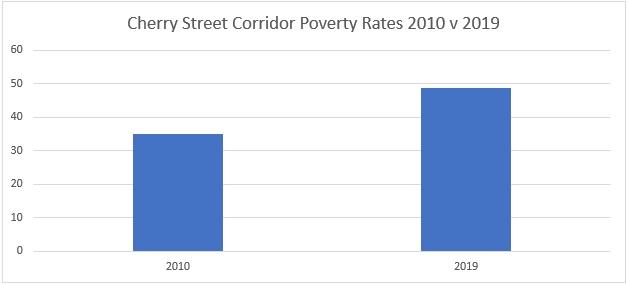The most important step to achieving economic equality is having the unemployed and underemployed engaged in high-wage jobs. Social welfare programs have not proven to address the long-term poverty challenges for many urban communities. Raising wage requirements for projects receiving economic development incentives is one method that can help retain and attract high-wage jobs as long as it is implemented at a statewide level. Individual cities raising wage requirements in a vacuum are likely to lose jobs to suburban and rural markets that can offer prospective employers higher skilled workers at lower wages. Wages also don’t matter if distressed neighborhoods struggling to address economic equality don’t have a workforce that is skilled and ready for work with both “hard” skills back up by educational achievements and skill certification but also “soft” skills so important for a workers success in the short and long-run. Most of these struggling urban centers have a population with well below average educational achievement that make climbing the economic ladder a challenge.

The Cherry Street Corridor just outside of Downtown Toledo, Ohio illustrates the workforce delimna facing this community. The Median Household Income of the Cherry Street Corridor is $30,609, far below the Median Household Income level of the state of Ohio at $46,924, and this area has a minority population of 71%. As the table below illustrates, the Cherry Street Corridor has seen a dramatic rise what was already a poverty rate over double the national average. By almost any measure, the Cherry Street Cooridor is struggling substantially from an economic development standpoint.
Only 4.42 % of the population in the census tracts making up the Cherry Street Corridor have a bachelor’s degree which is incredibly low compared to the national U.S. average of over 30%, compared to Toledo’s low bachelor degree rate of 18%, Ohio’s rate of 27% and Lucas County’s rate of 26%.
Addressing urban poverty through a workforce development program needs to be accomplished through five distinct steps recommend by McKinsey: define regional assets and identify target professions; deliver a defined Return on Investment to employers and workers; support comprehensive, demand-driven training methods tied to regional educational institutions; assess and prepare learners before they start training; and coordinate the workforce-development process centrally. Successful workforce development demands industry and regional collaboration. Again, McKinsey suggests such efforts typically take three forms: down a supply chain, with an anchor company taking the lead in encouraging its suppliers to participate; by a functional profession that is in demand by employers in different industries in the same location; and by sector, with competitors collaborating because they all face the same talent problem.
The answer to addressing these low educational levels driving high poverty rates lies in developing targeted workforce development programs tied to specific industries that are likely to grow serving only these distressed communities. As an example, the anticipated growth of the logistics, distribution and fulfillment center market in the near term is expected to be substantial driven by COVID 19’s dramatic increase in the use of e-commerce by consumers. Regions hoping to capitalize on this market growth should create a Logistics Workforce Training program designed in conjunction with industry and regional educational institutions to develop a skill pool of labor from these distressed communities. Building in incentives and support systems to help these residents prepare for a start in this industry than can be their first step in hopefully a long and successful workforce ladder is essential. Some good news relates to the funding of these programs. State and federal resources driven by COVID 19 may be good source of workforce development funding tied not just to the impact of the virus but also to long-term economic equity challenges. Finally, regions need to understand how these workers will travel to these job centers. Regional transit organizations need to be engaged to develop the funding and partnerships needed for these newly skilled workers to be connected to their jobs. States should consider new transportation revenue streams for these transit agencies tied to economic development projects where state grants can pay for new bus or transit routes to be created tied to regional job centers.
Montrose Group is engaged with several communities and companies focused on economic equity projects and please contact Dave Robinson at [email protected] if we can help your company or community address these issues.